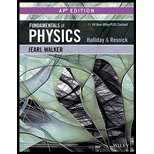
FUNDAMENTALS OF PHYSICS,AP ED.
11th Edition
ISBN: 9781119472780
Author: Halliday
Publisher: WILEY
expand_more
expand_more
format_list_bulleted
Question
Chapter 41, Problem 36P
To determine
To find:
(a) if the Fermi level is above or below the top of the silicon valence band.
(b) how far, above or below, is this Fermi level (as calculated in (a)).
(c) the probability that a state at the bottom of the silicon
Expert Solution & Answer
Want to see the full answer?
Check out a sample textbook solution
Students have asked these similar questions
Deduce what overvoltage is like in reversible electrodes.
pls help on these
pls help on these
Chapter 41 Solutions
FUNDAMENTALS OF PHYSICS,AP ED.
Ch. 41 - Prob. 1QCh. 41 - Prob. 2QCh. 41 - Prob. 3QCh. 41 - Prob. 4QCh. 41 - Prob. 5QCh. 41 - Prob. 6QCh. 41 - Prob. 7QCh. 41 - Prob. 8QCh. 41 - Prob. 9QCh. 41 - Prob. 10Q
Ch. 41 - Prob. 11QCh. 41 - Prob. 1PCh. 41 - Prob. 2PCh. 41 - Prob. 3PCh. 41 - Prob. 4PCh. 41 - Prob. 5PCh. 41 - Prob. 6PCh. 41 - Prob. 7PCh. 41 - Prob. 8PCh. 41 - Prob. 9PCh. 41 - Prob. 10PCh. 41 - Prob. 11PCh. 41 - Prob. 12PCh. 41 - Prob. 13PCh. 41 - Prob. 14PCh. 41 - Prob. 15PCh. 41 - Prob. 16PCh. 41 - Prob. 17PCh. 41 - Prob. 18PCh. 41 - Prob. 19PCh. 41 - Prob. 20PCh. 41 - Prob. 21PCh. 41 - Prob. 22PCh. 41 - Prob. 23PCh. 41 - Prob. 24PCh. 41 - Prob. 25PCh. 41 - Prob. 26PCh. 41 - Prob. 27PCh. 41 - Prob. 28PCh. 41 - Prob. 29PCh. 41 - Prob. 30PCh. 41 - Prob. 31PCh. 41 - Prob. 32PCh. 41 - Prob. 33PCh. 41 - Prob. 34PCh. 41 - Prob. 35PCh. 41 - Prob. 36PCh. 41 - Prob. 37PCh. 41 - Prob. 38PCh. 41 - Prob. 39PCh. 41 - Prob. 40PCh. 41 - Prob. 41PCh. 41 - Prob. 42PCh. 41 - Prob. 43PCh. 41 - Prob. 44PCh. 41 - Prob. 45PCh. 41 - Prob. 46PCh. 41 - Prob. 47PCh. 41 - Prob. 48PCh. 41 - Prob. 49PCh. 41 - Prob. 50PCh. 41 - Prob. 51PCh. 41 - Prob. 52PCh. 41 - Prob. 53P
Knowledge Booster
Similar questions
- 20. Two small conducting spheres are placed on top of insulating pads. The 3.7 × 10-10 C sphere is fixed whie the 3.0 × 107 C sphere, initially at rest, is free to move. The mass of each sphere is 0.09 kg. If the spheres are initially 0.10 m apart, how fast will the sphere be moving when they are 1.5 m apart?arrow_forwardpls help on allarrow_forwardpls help on thesearrow_forward
- pls help on all asked questions kindlyarrow_forwardpls help on all asked questions kindlyarrow_forward19. Mount Everest, Earth's highest mountain above sea level, has a peak of 8849 m above sea level. Assume that sea level defines the height of Earth's surface. (re = 6.38 × 106 m, ME = 5.98 × 1024 kg, G = 6.67 × 10 -11 Nm²/kg²) a. Calculate the strength of Earth's gravitational field at a point at the peak of Mount Everest. b. What is the ratio of the strength of Earth's gravitational field at a point 644416m below the surface of the Earth to a point at the top of Mount Everest? C. A tourist watching the sunrise on top of Mount Everest observes a satellite orbiting Earth at an altitude 3580 km above his position. Determine the speed of the satellite.arrow_forward
- pls help on allarrow_forwardpls help on allarrow_forward6. As the distance between two charges decreases, the magnitude of the electric potential energy of the two-charge system: a) Always increases b) Always decreases c) Increases if the charges have the same sign, decreases if they have the opposite signs d) Increases if the charges have the opposite sign, decreases if they have the same sign 7. To analyze the motion of an elastic collision between two charged particles we use conservation of & a) Energy, Velocity b) Momentum, Force c) Mass, Momentum d) Energy, Momentum e) Kinetic Energy, Potential Energyarrow_forward
- pls help on all asked questions kindlyarrow_forwardpls help on all asked questions kindlyarrow_forward17. Two charges, one of charge +2.5 × 10-5 C and the other of charge +3.7 × 10-6 C, are 25.0 cm apart. The +2.5 × 10−5 C charge is to the left of the +3.7 × 10−6 C charge. a. Draw a diagram showing the point charges and label a point Y that is 20.0 cm to the left of the +3.7 × 10-6 C charge, on the line connecting the charges. (Field lines do not need to be drawn.) b. Calculate the net electric field at point Y.arrow_forward
arrow_back_ios
SEE MORE QUESTIONS
arrow_forward_ios
Recommended textbooks for you
 Modern PhysicsPhysicsISBN:9781111794378Author:Raymond A. Serway, Clement J. Moses, Curt A. MoyerPublisher:Cengage Learning
Modern PhysicsPhysicsISBN:9781111794378Author:Raymond A. Serway, Clement J. Moses, Curt A. MoyerPublisher:Cengage Learning Physics for Scientists and Engineers with Modern ...PhysicsISBN:9781337553292Author:Raymond A. Serway, John W. JewettPublisher:Cengage Learning
Physics for Scientists and Engineers with Modern ...PhysicsISBN:9781337553292Author:Raymond A. Serway, John W. JewettPublisher:Cengage Learning University Physics Volume 3PhysicsISBN:9781938168185Author:William Moebs, Jeff SannyPublisher:OpenStax
University Physics Volume 3PhysicsISBN:9781938168185Author:William Moebs, Jeff SannyPublisher:OpenStax Glencoe Physics: Principles and Problems, Student...PhysicsISBN:9780078807213Author:Paul W. ZitzewitzPublisher:Glencoe/McGraw-Hill
Glencoe Physics: Principles and Problems, Student...PhysicsISBN:9780078807213Author:Paul W. ZitzewitzPublisher:Glencoe/McGraw-Hill

Modern Physics
Physics
ISBN:9781111794378
Author:Raymond A. Serway, Clement J. Moses, Curt A. Moyer
Publisher:Cengage Learning

Physics for Scientists and Engineers with Modern ...
Physics
ISBN:9781337553292
Author:Raymond A. Serway, John W. Jewett
Publisher:Cengage Learning

University Physics Volume 3
Physics
ISBN:9781938168185
Author:William Moebs, Jeff Sanny
Publisher:OpenStax

Glencoe Physics: Principles and Problems, Student...
Physics
ISBN:9780078807213
Author:Paul W. Zitzewitz
Publisher:Glencoe/McGraw-Hill

